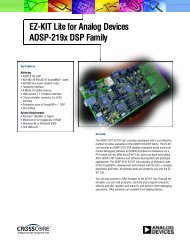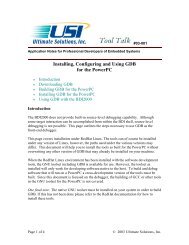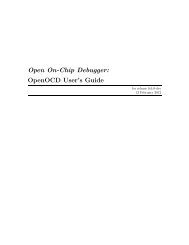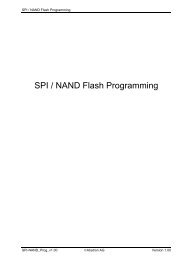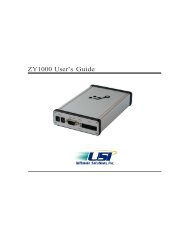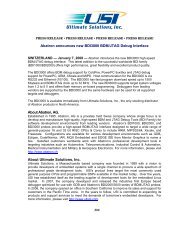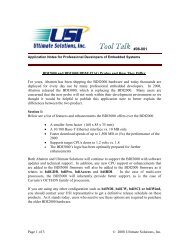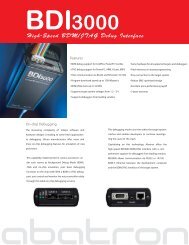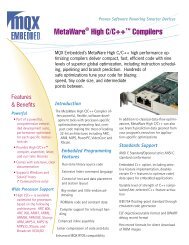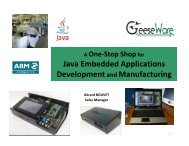STM32 Journal - Digikey
STM32 Journal - Digikey
STM32 Journal - Digikey
You also want an ePaper? Increase the reach of your titles
YUMPU automatically turns print PDFs into web optimized ePapers that Google loves.
<strong>STM32</strong> <strong>Journal</strong><br />
when shuffling through a large<br />
library of albums.<br />
Digital audio has commonly<br />
been implemented in consumer<br />
electronics and embedded<br />
applications using a second<br />
processor dedicated to this task.<br />
To meet market cost pressures,<br />
however, manufacturers need to<br />
be able to process audio on the<br />
host CPU.<br />
In general, it is easier to<br />
implement audio on an MCU<br />
than it is to implement real-time<br />
responsiveness and connectivity<br />
on a DSP. DSPs, while excellent<br />
at processing audio, don’t have<br />
the peripherals or interrupt<br />
responsiveness required for realtime<br />
systems. DSP architectures<br />
are also typically designed for<br />
high-end signal processing<br />
and massive parallelism that<br />
exceeds the requirements of the<br />
typical consumer application. In<br />
addition, DSPs are not designed<br />
to support communication<br />
interfaces like USB, SD cards, or<br />
Wi-Fi, so a DSP-based docking<br />
station would still require a<br />
second processor to handle<br />
connectivity.<br />
With the introduction of DSP<br />
capabilities to MCU instruction<br />
sets, MCUs now have the<br />
advanced math processing<br />
System<br />
Power supply<br />
1.2 V regulator<br />
POR/PDR/PVD<br />
Xtal oscillators<br />
32 kHz + 4 ~26 MHz<br />
Internal RC oscillators<br />
32 kHz + 16 MHz<br />
PLL<br />
Clock control<br />
RTC/AWU<br />
SysTick timer<br />
2x watchdogs<br />
(independent and window)<br />
51/82/114/140 I/Os<br />
Cyclic redundancy<br />
check (CRC)<br />
Control<br />
2x 16-bit motor control<br />
PWM<br />
Synchronized AC timer<br />
10x 16-bit timers<br />
2x 32-bit timers<br />
capabilities required to handle<br />
not only basic audio processing<br />
but the advanced algorithms<br />
required to improve quality as<br />
well. In addition, rather than<br />
requiring developers to handcode<br />
assembly as is typical for<br />
DSP-based designs, MCUs offer<br />
ease-of-use and faster time-tomarket<br />
through C programming<br />
and application libraries.<br />
MCUs are also specifically<br />
ART Accelerator<br />
<strong>STM32</strong> F4<br />
ARM Cortex-M4<br />
168 MHz<br />
Floating-point unit (FPU)<br />
Nested vector<br />
interrupt<br />
controller (NVIC)<br />
MPU<br />
JTAG/SW debug/ETM<br />
Multi-AHB bus matrix<br />
16-channel DMA<br />
Crypto/hash processor<br />
3DES, AES 256<br />
SHA-1, MD5, HMAC<br />
True random number generator (RNG)<br />
architected to provide short and<br />
deterministic interrupt latency as<br />
well as ultra low-power operation<br />
for battery-powered applications.<br />
The <strong>STM32</strong> MCU + Audio<br />
Architecture<br />
The <strong>STM32</strong> architecture from<br />
ST has been designed to<br />
bring 32-bit MCU capabilities<br />
to a wide range of consumer<br />
audio applications, including<br />
Up to 1-Mbyte Flash memory<br />
Up to 192-Kbyte SRAM<br />
FSMC/SRAM/NOR/NAND/CF/LCD<br />
parallel interface<br />
80-byte + 4-Kbyte backup SRAM<br />
512 OTP bytes<br />
Connectivity<br />
Camera interface<br />
3x SPI, 2x I 2 S, 3x I 2 C<br />
Ethernet MAC 10/100<br />
with IEEE 1588<br />
2x CAN 2.0B<br />
1x USB 2.0 OTG FS/HS<br />
1x USB 2.0 OTG FS<br />
SDIO<br />
6x USART<br />
LIN, smartcard, lrDA,<br />
modem control<br />
Analog<br />
2-channel 2x 12-bit DAC<br />
3x 12-bit ADC<br />
24 channels / 2.4 MSPS<br />
Temperature sensor<br />
Figure 1 ST has expanded its <strong>STM32</strong> MCUs beyond the base Cortex-M architecture with a variety of integrated peripherals<br />
to create a wide range of MCUs that optimize performance, memory, and cost for nearly every embedded application.<br />
multimedia speakers, docking<br />
stations, and headphones. The<br />
<strong>STM32</strong> F4, based on an ARM<br />
Cortex-M4 core operating at<br />
up to 168 MHz, also integrates<br />
capabilities such as DSP<br />
instructions and a floating-point<br />
unit to allow manufacturers<br />
to produce consumer audio<br />
applications offering quality<br />
playback at the lowest cost<br />
(see Figure 1).<br />
12




